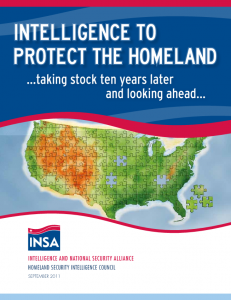INSA recommends actions for improving homeland security intelligence
 Today is the ten-year anniversary of 9/11/2001. As we honor the sacrifies of those who perished in the horrible events of that day, we must remember that it is is really what we do EVERY DAY that will help to prevent future attacks on our soil, or the soil of our friends and allies. At the heart of issue is “homeland security intelligence”…the information and data that we will need to deter, detect, and disrupt the activities of those to wish us harm.
Today is the ten-year anniversary of 9/11/2001. As we honor the sacrifies of those who perished in the horrible events of that day, we must remember that it is is really what we do EVERY DAY that will help to prevent future attacks on our soil, or the soil of our friends and allies. At the heart of issue is “homeland security intelligence”…the information and data that we will need to deter, detect, and disrupt the activities of those to wish us harm.
On September 7, 2011, the Intelligence and National Security Alliance’s (INSA) Homeland Security Intelligence Council (HSIC) released a white paper proposing significant recommendations for Homeland Security Intelligence. The white paper, entitled “Intelligence to Protect the Homeland: Taking stock ten years later and looking ahead,” examines what has been learned in the last ten years and what will be needed from the intelligence community to protect the homeland from future attacks. My friend and colleague Joe Rozek, who chairs the INSA Homeland Security Intelligence Council, commented:
“The HSIC has worked tirelessly for months and today we are proud to offer our analysis and recommendations to the intelligence and homeland security communities on the 10 year anniversary of September 11th, Homeland Security Intelligence is a discipline that will depend on the successful fusion of foreign and domestic intelligence to produce the kind of actionable intelligence to protect the homeland. Yet, underpinning our analysis is the foundational principle that respect for privacy and civil liberties is an inherent, inseparable part of our national security and core values as a nation.”The major recommendations in the HSIC white paper include:
- Adopting a common definition for Homeland Security Intelligence (HSI) to better facilitate its collection, analysis, and use in decision making, as well as development as a discipline;
- Departing from the “command and control” or top-down hierarchical model and moving toward an integrated enterprise characterized by coordination of intelligence and analysis efforts among federal, state, local, tribal law enforcement and intelligence agencies;
- As appropriate, bringing select private sector partners into the enterprise; and
- Ensuring the protection of Americans’ privacy and civil liberties through widely applicable training and accountability standards to ensure lawful and aggressive detection and deterrence of terrorist operations in the U.S.
Take some time to read this white paper and I’d be interested in your comments and thoughts…r/Chuck